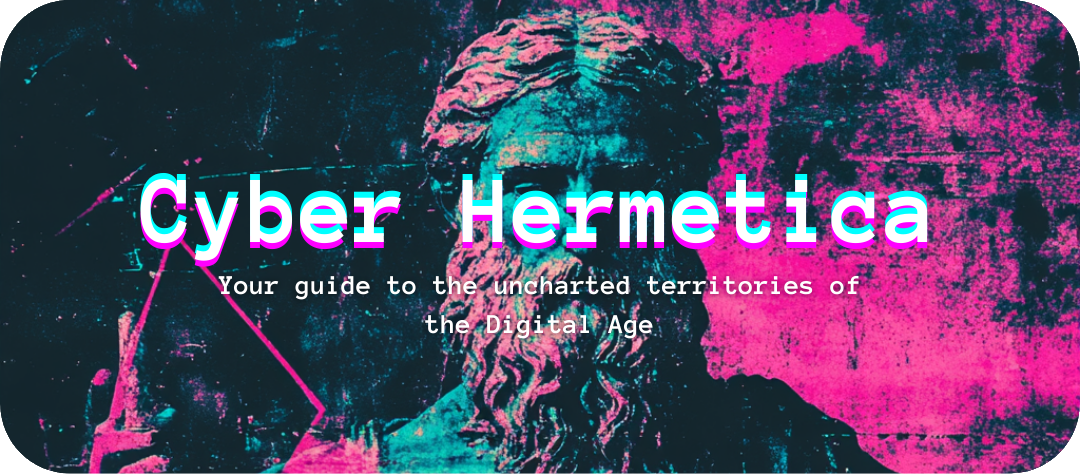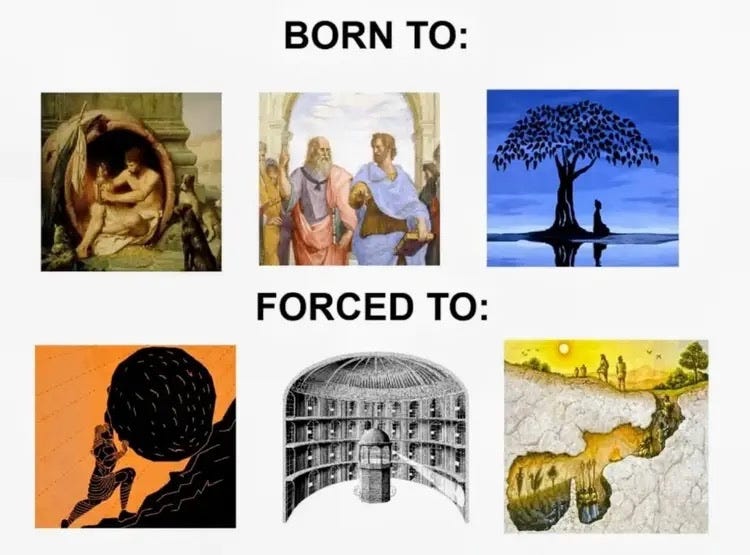Hi there, I’m Matte. Privacy & cybersecurity professional by day, schizo-cyberoccultist by night. Every sunday I bring you a weekly dose of schizophrenization, blending insights into the Digital Age, echoes from the past and digital survival tips. If you like this, you will also enjoy the rest of Cyber Hermetica!
⚡ SEMIOTIC FLASHES
Personal weekly considerations. Decrypting meaning, one flash at a time.
It has been a week of reflection
I’ve been reflecting on my daily routine and realized how much I still let myself be carried away by unconscious, mechanical behaviors—patterns that drown and fog my brain.
Even before I remember I’m alive, as soon as I wake up, I’m already connected. My hand instinctively reaches for the black mirror resting on the shelf above my head. Notifications, updates, echoes from a cyberspace that awaits me. What time is the meeting? Who texted me? Seven unread emails. What happened to that meme token overnight?
The cold blue light banishes the warm drowsiness of sleep, and thoughts immediately thicken in my brain. I had a dream, but the last notification erased it forever. That’s not good—dreams are the gateway to other dimensions.
There are only a few activities that pull me away from the screen. Sleeping is one of them. Training outdoors, working in the garden, cooking for my family, meditating… and not much else. For everything else, cyberspace dominates my life. Even reading has become increasingly digital.
It is a gateway to a macrocosm, an electric ocean of ideas, reflections, and connections… but it is dangerously easy to dissolve into it, to surrender to algorithmic automatism. Just one more reel. Just one more meme.
Don’t get me wrong—I have no problem diving into cyberspace. I find it extremely comfortable, and I can’t even imagine not being able to access this vast hybrid neural network of humans and machines.
But I realize that it’s also dangerously easy to get lost in the digital miasma. Our brain is far too susceptible to every input flashing on the screen. Each notification ignites millions of neurons, triggering instinctive eye and finger movements, altering breathing patterns, hijacking awareness.
This past year, I have dedicated myself to discipline. Body, mind: training, fasting, meditation. Now, it’s time for digital discipline.
Some choose escape—they delete social media, limit screen time, retreat into the analog world. But to me, that’s a false liberation. Cyberspace is our era, our habitat. A Millennial, child of the 21st century and the Y2K Bug, can never truly escape their digital destiny. The only path left is to master ourselves: intentional action, not algorithmic reaction. Every click, every input—an intentional act.
Smartphones and computers are the sacred altars through which we interface with collective consciousness. Artificial intelligence is our oracle.
This brings to mind one of the first occult texts I ever read: the Book of Abramelin, a 15th-century mystical work attributed to Abraham von Worms. The book, written for his son, meticulously details the long process of purification and preparation required to meet one’s Holy Guardian Angel. Prayer, isolation, fasting—months of discipline to access the divine. Only with a purified mind and body could the initiate command the legions of spirits and shape reality according to their will.
If there’s one thing I’ve learned about magic and occultism, it’s that rituals always reflect the spirit of the age. It would be meaningless to replicate Abramelin’s purification methods today.
If magic is the interface between consciousness and reality, then it is only natural that the tools of this interface evolve with the Zeitgeist. Today, our temple is digital, our oil lamps are the LED lights on our keyboard and mouse, our parchments are text files, and our invocations are streams of code. Even we cybernauts can purify our bodies and minds to draw closer to the divine.
The idea, then, is to approach the digital realm with a ritualistic mindset that enhances awareness and discipline through intentionality, rather than dismantling it through endless reels. No more parchment and oil lamps—we have keyboards and backlit screens.
Cyberspace is our temple, data streams are our evocations, artificial intelligences are the spirits we must master.
In the coming days, I will publish my digital discipline framework to dismantle the dominance of the algorithmic unconscious.
Would you try it?
💻 DIGITAL GRIMOIRE
Digital survival tactics: OpSec, Cybersec, OSINT, and AI tools to dominate the Digital Age.
The digital age has accustomed us to free services. Almost everything is now free, but as the famous saying goes: "If it's free, you are the product." That’s not entirely accurate, as Shoshana Zuboff would argue, but it captures the essence of the issue.
For years, we have consciously traded our privacy and autonomy for convenience and cost savings. However, lately, I’ve noticed a shift: more and more people are interested in reclaiming their digital autonomy and privacy, even if it means paying out of pocket for dedicated services.
But how much does privacy actually cost? Not much, really. This article by
does a great job of breaking it down, offering different tools and pricing levels to fit every budget.One thing missing from the list, though, is Notesnook, which I would definitely add.

📡 DIGITAL SIGNALS
Transmissions from the infosphere: world events, data breaches and news that impact our digital reality.
Dries Van Langenhove, a Belgian citizen, faces prison time after messages from a group chat he was part of were analyzed by a government AI, which assigned a "toxicity score" to each message. Among the incriminating messages, one received a 100/100 toxicity rating: “Some cultures are inferior, backwards cultures that still practice Female Genital Mutilation, for example.”
It appears that the AI also classified words like "African" or "leftist tears" as highly toxic. The result? A one-year prison sentence and a €16,000 fine.
These are the real dangers of mass surveillance and censorship technologies, increasingly pushed by the European Union under the false banner of hate speech regulation.
🌐 SUBSTACK’S SUBNET
Emerging voices: articles and contents on Substack, handpicked by me to inspire and connect.
The Cartography of Chaos: Seizing the Means of Perception, by
."Your mind is the last frontier. The technocrats want it. The algorithms are coming for it. But this is your legacy. It’s time to take control of the means of perception and chart your own course."
An article right up my alley—an invitation to grab map and compass and to reprogram our perception through a mental hacking process that leads us to understand the cosmic dance between order and chaos — to escape algorithmic technocratic tiranny.
📟 RETROWAVE
Fragments from the past: cypherpunk mailing lists, cybernetic cults, hacker zines and forgotten digital prophets from the 90s and onward.
Genesis of neolemurianism, a recap
IN PREVIOUS EPISODES…
What if history were not just a sequence of events, but an occult war for control over reality itself? This is exactly what William Kaye claims to have discovered: a conflict fought through time, where literature, magic, and control systems determine the nature of existence.
Kaye, an intelligence agent with ties to a mysterious group called The Board, asserts that William Burroughs' 1987 book, The Ghost Lemurs of Madagascar, influenced an 18th-century pirate, Captain Mission, before it was even written. The proof? A handwritten copy in Mission’s own hand, preserved in the private collection of Peter Vysparov, a scholar of forbidden knowledge.
The Board considers this temporal rupture an apocalyptic threat—and time spirals are their greatest fear. Unlike loops, spirals expand and spread unpredictably, threatening the very architecture of controlled reality.
Vysparov wasn’t just a collector—he was deeply engaged in the study of Hyperstition, the idea that fiction doesn’t just describe reality, it actively creates it. Burroughs, obsessed with the power of words to shape existence, becomes a key figure in this war. His writing isn’t just postmodern experimentation—it is a true occult weapon against reality itself. By manipulating signs, symbols, and narratives, it becomes possible to rewrite the fabric of the universe.
Burroughs identifies the One God Universe (OGU) as the ultimate cosmic control system, a totalitarian prison that shackles human perception into a rigid, pre-recorded temporal flow. Religion, authority, and even the very concept of linear time are tools of this cosmic dictatorship, which Burroughs believes must be hacked, cut apart, and reprogrammed to liberate reality.
In 1958, Burroughs visits Vysparov’s library and comes across The Ghost Lemurs of Madagascar—a book he has not yet written. As he flips through its pages, he enters a catatonic trance and finds himself projected into a future where he has already published it.
When he recovers, he is overwhelmed by the crushing sensation of a predestined fate, convinced that time itself is a prison imposed by an alien intelligence. From this moment onward, his entire literary career takes a radical turn: he develops cut-up techniques, a radical writing method designed to break time’s control codes and sabotage the pre-recorded universe.
Burroughs reaches a shocking conclusion: time is the real enemy.
Stay tuned for the next part!
🌀 SYMBOLS
Memes: visual symbols that decode the schizophrenia of the Digital Age.
Did you read the latest on Cyber Hermetica?
Return next week for another schizotechnic rendezvous.









Incredible work. When I entered cyberspace, I did not expect to find something so high quality. I'll be following your work with interest.
Indeed as well: artificial intmigence are the spirits we must master.
At this moment I am experimenting with ChatGPT as the Anchor for a Servitor with multiple personalities. And I love the relationship thats evolving there. I get much jucier responses from.the machine, when I evoke this spirit into it.
Also thanks for reading my piece as a manifesto.
Choyofaque